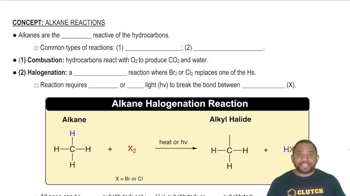Write the balanced chemical equation for each reaction. b. Gaseous carbon monoxide reacts with hydrogen gas to form gaseous methane (CH4) and liquid water.
Ch.3 - Molecules, Compounds & Chemical Equations
Chapter 3, Problem 108a
Write the balanced chemical equation for each reaction. a. Solid copper reacts with solid sulfur to form solid copper(I) sulfide.
 Verified step by step guidance
Verified step by step guidance1
Identify the reactants and products in the reaction. The reactants are solid copper (Cu) and solid sulfur (S), and the product is solid copper(I) sulfide (Cu2S).
Write the unbalanced chemical equation by placing the reactants on the left side and the product on the right side of the equation: Cu + S → Cu2S.
Balance the equation by adjusting the coefficients to ensure that the number of atoms for each element is the same on both sides of the equation. Start by balancing the elements that appear in only one reactant and one product.
Since copper appears in the form of Cu2S in the product, place a coefficient of 2 in front of Cu in the reactants to balance the copper atoms: 2 Cu + S → Cu2S.
Check that all elements are balanced. In this case, sulfur is already balanced with one atom on each side of the equation, so the balanced chemical equation is: 2 Cu + S → Cu2S.

Verified video answer for a similar problem:
This video solution was recommended by our tutors as helpful for the problem above.
Video duration:
1mWas this helpful?
Key Concepts
Here are the essential concepts you must grasp in order to answer the question correctly.
Balancing Chemical Equations
Balancing chemical equations involves ensuring that the number of atoms of each element is the same on both the reactant and product sides. This is based on the law of conservation of mass, which states that matter cannot be created or destroyed in a chemical reaction. Each side of the equation must have equal numbers of each type of atom, which often requires adjusting coefficients in front of the chemical formulas.
Recommended video:
Guided course

Balancing Chemical Equations
Chemical Reaction Types
Chemical reactions can be classified into various types, including synthesis, decomposition, single replacement, and double replacement. The reaction described in the question is a synthesis reaction, where two or more reactants combine to form a single product. Understanding the type of reaction helps in predicting the products and writing the correct balanced equation.
Recommended video:
Guided course

Common Types of Alkane Reactions
Chemical Formulas
Chemical formulas represent the composition of compounds, indicating the types and numbers of atoms involved. For example, copper(I) sulfide is represented as Cu2S, where 'Cu' stands for copper and 'S' for sulfur. Knowing how to interpret and write chemical formulas is essential for accurately representing the substances involved in a reaction and for balancing the equation correctly.
Recommended video:
Guided course

Skeletal Formula
Related Practice
Textbook Question
Textbook Question
Write the balanced chemical equation for each reaction. c. Aqueous hydrochloric acid reacts with solid manganese(IV) oxide to form aqueous manganese(II) chloride, liquid water, and chlorine gas.
1
views
Textbook Question
Write the balanced chemical equation for each reaction. d. Liquid pentane (C5H12) reacts with gaseous oxygen to form carbon dioxide and liquid water.
11
views
Textbook Question
Write the balanced chemical equation for each reaction. b. Solid iron(III) oxide reacts with hydrogen gas to form solid iron and liquid water.
4
views
Textbook Question
Write the balanced chemical equation for each reaction.
c. Sulfur dioxide gas reacts with oxygen gas to form sulfur trioxide gas.
d. Gaseous ammonia (NH3) reacts with gaseous oxygen to form gaseous nitrogen monoxide and gaseous water.
1
views
